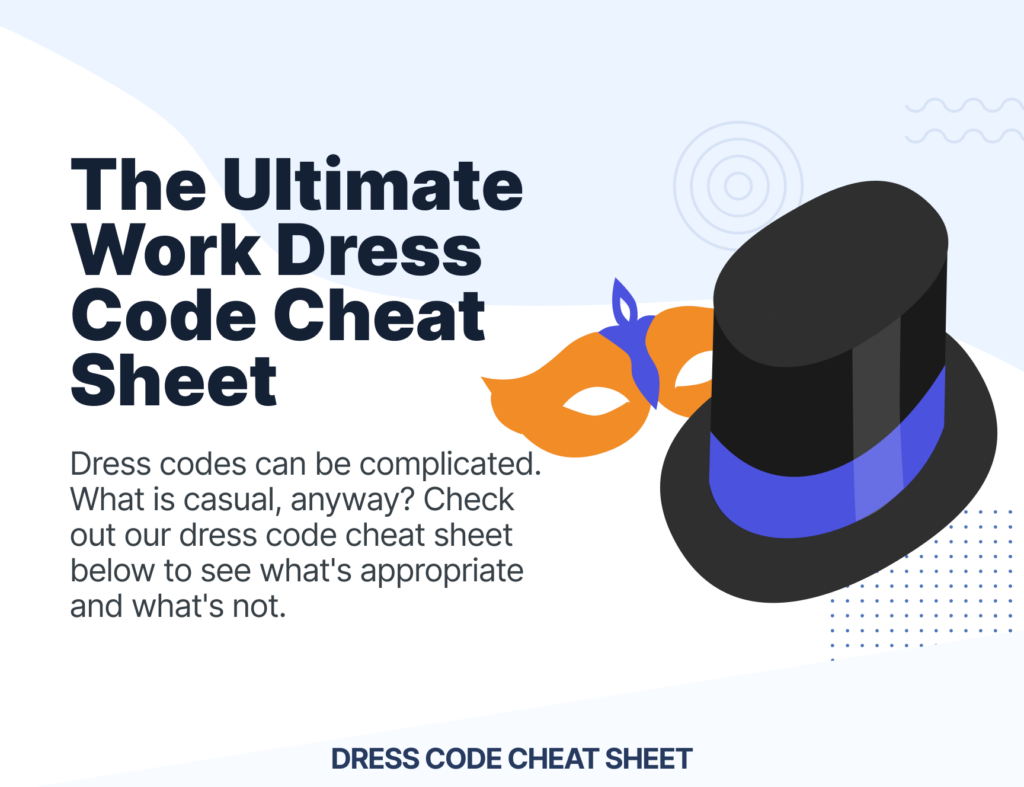-
 14 min. read
14 min. read
-
 Trevin Shirey
Trevin Shirey VP of Marketing
VP of Marketing
- Trevin serves as the VP of Marketing at WebFX. He has worked on over 450 marketing campaigns and has been building websites for over 25 years. His work has been featured by Search Engine Land, USA Today, Fast Company and Inc.
Dress codes are complicated. They all sound similar, and there’s a lot of disagreement as to what a dress code implies across the board. So how can someone hope to get and hold a job when they’re not even clear on what they should wear?
That’s why we made this infographic. WebFX hires a lot of fresh college graduates who majored in almost everything you can imagine. So not everyone is on the same page when someone says “business casual” or “semi-formal.” If you find yourself in a similar situation — or if you just want some fashion guidelines — learn what to wear for your work’s dress code below.
Dress Code Cheat Sheet

1. Unacceptable
“Unacceptable” attire is a bit of a misnomer. Depending on where you work, some of the below clothing might be acceptable. The reason it’s labeled “unacceptable” is that it looks totally unprofessional.
This clothing is the kind of thing you’d expect to see someone wearing when they lounge around the house. Or surfing. Or when they’re 22. For the most part, these restrictions are implied unless your employer states otherwise. 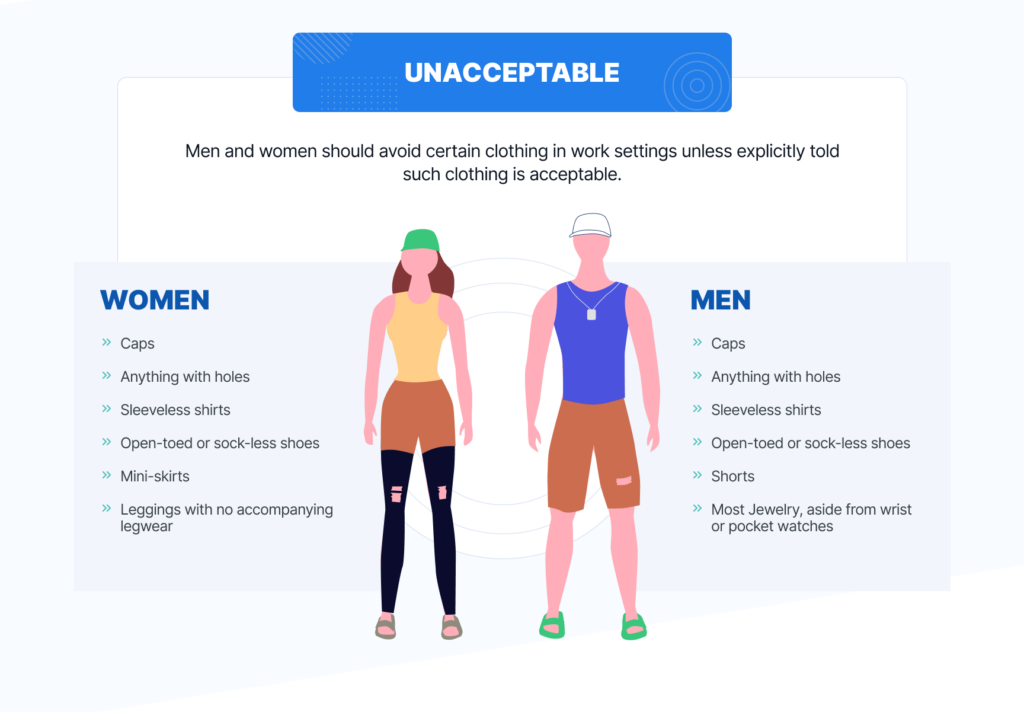 Unacceptable clothing is pretty similar for men and women. Generally, don’t wear hats, clothes with holes, clothes with stains, sleeveless shirts, sandals, shorts, or anything too revealing.
Unacceptable clothing is pretty similar for men and women. Generally, don’t wear hats, clothes with holes, clothes with stains, sleeveless shirts, sandals, shorts, or anything too revealing.
However, as American corporate culture gradually becomes more relaxed, this kind of clothing is becoming more common in entry-level, artistic, and non-client-facing positions. So if you’re a graphic designer in the marketing department, you might dress something like this every day and it’s totally fine. But there’s one important guideline that everyone should follow at a job, no matter how relaxed your dress code is.
Lose the thumb ring.
2. Ultra-casual
Ultra-casual dress (or “ultra-caz,” for those in a hurry) is a fairly new dress code that got its start in companies looking for results from its employees without the expectation of appearances. Ultra-casual attire is pretty much what someone would wear out with their friends while still “looking nice.” It’s a huge fad with businesses that hire younger, tech-savvy workers, and it helps their employees save money for other purchases aside from clothing. In other words, if your business is “cool” with you wearing a T-shirt to work, you work in an ultra-casual environment.
Also, if they use the phrase “we’re cool with T-shirts,” that’s a good indication too. 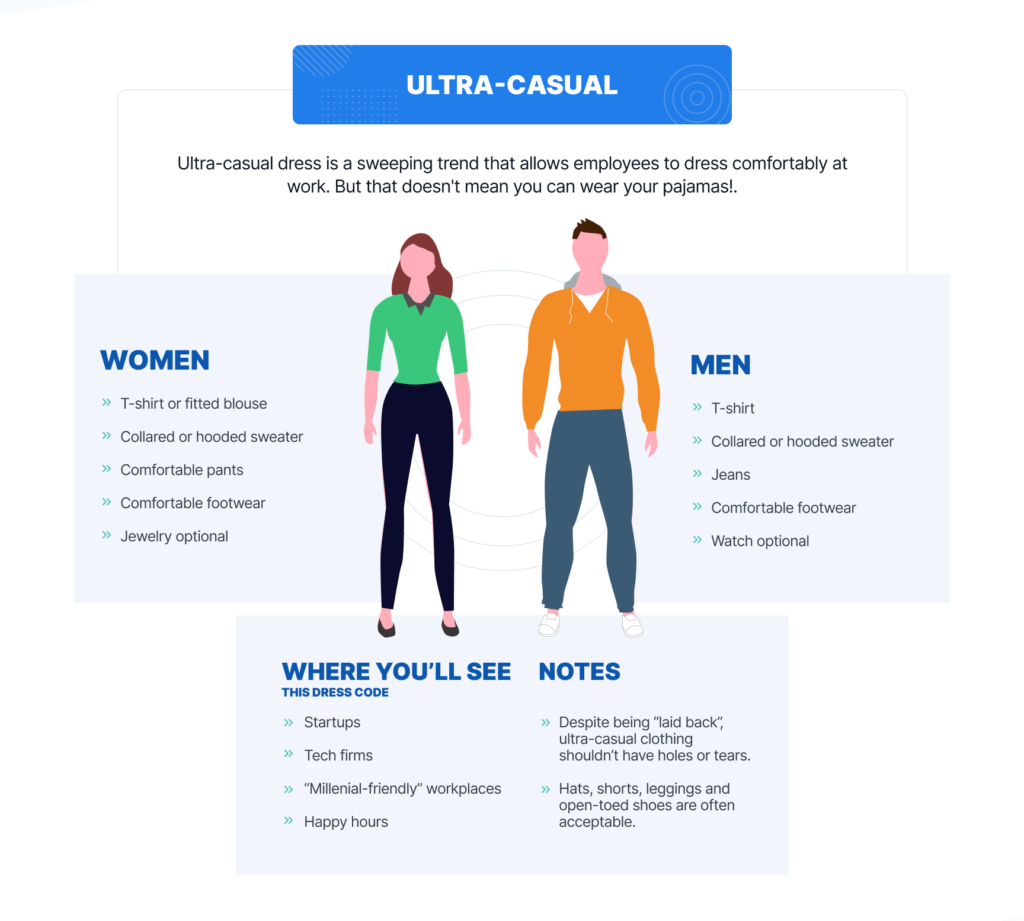 This is a super-similar dress code for men and women since the more casual you get, the more you’ll find unisex clothing. T-shirts, sweatshirts, fitted shirts, comfortable pants, comfortable footwear, and optional jewelry are all guidelines for this dress code, and you can pretty much go hog-wild with whatever else you want to add.
This is a super-similar dress code for men and women since the more casual you get, the more you’ll find unisex clothing. T-shirts, sweatshirts, fitted shirts, comfortable pants, comfortable footwear, and optional jewelry are all guidelines for this dress code, and you can pretty much go hog-wild with whatever else you want to add.
But lots of businesses usually limit ultra-casual wear to some degree. Some companies may not allow graphics on shirts, and it’s generally considered “bad taste” to wear something with profanity on it. Your clothes should also be free of holes, stains, tears, and other problems that would make it look unfit for an office.
Ultra-casual is still a dress code, which means you should still look decent when you go to work every day. So you probably don’t want to look like the cast of Blossom… 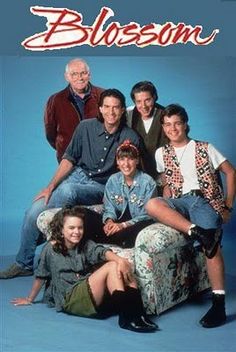 …but, you know, have fun with it.
…but, you know, have fun with it.
3. Casual
For many years, casual dress was the “lowest” and most versatile dress code a business could have. While it still has its guidelines, it’s more based around comfort than appearance. That’s one of the reasons it’s become so popular in the startup scene with new modern businesses.
The casual style isn’t just “anything goes,” though — it still requires effort and decent clothing. 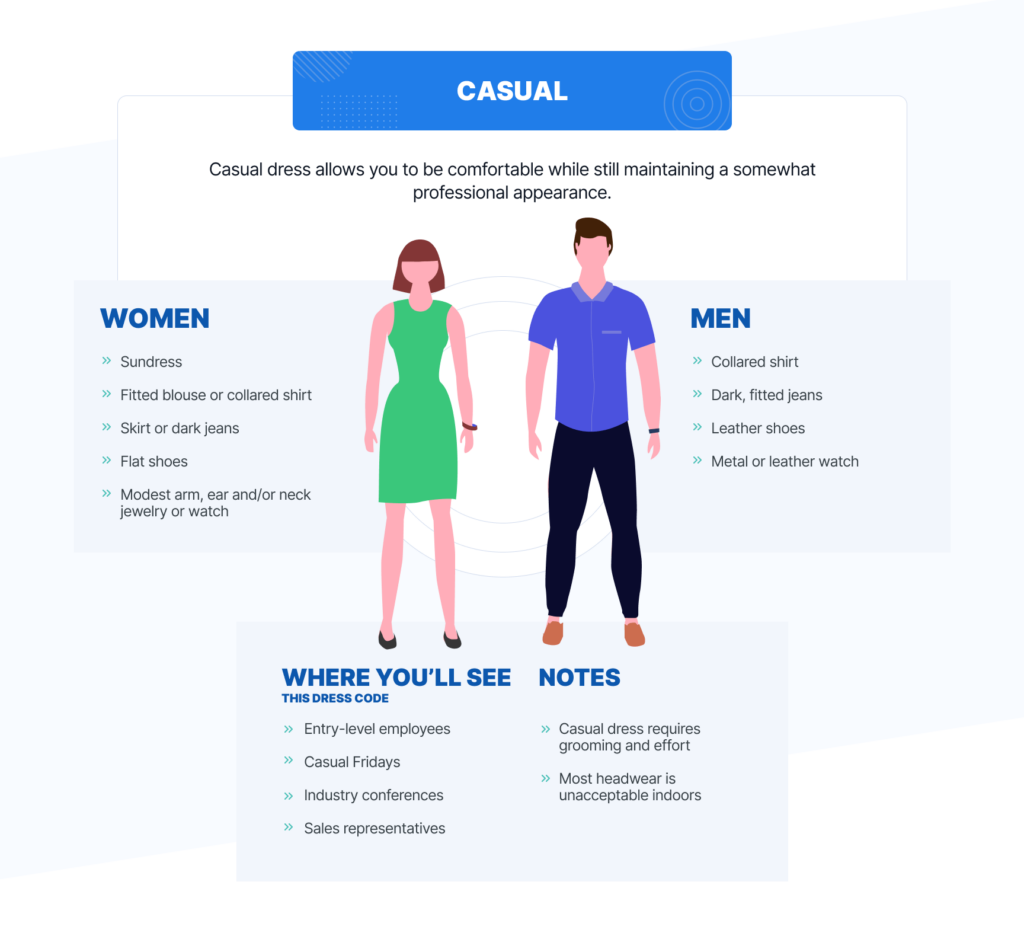 For men, casual dress requires a collared shirt, dark jeans, leather shoes, and maybe a watch. It’s a super-simple dress code that can still look nice, provided you have the eye for it.
For men, casual dress requires a collared shirt, dark jeans, leather shoes, and maybe a watch. It’s a super-simple dress code that can still look nice, provided you have the eye for it.
For women, casual dress implies a simple dress, fitted top, skirt, dark jeans, flat shoes, and modest accessories. Again, it’s a fairly simple dress code, and it has lots of opportunities for variation. For both sexes, headwear is generally unacceptable.
Except golfers. They go wild with the visors.
4. Business casual
Business casual is the standard dress code for most established businesses in the world. It requires clothing that’s affordable, but still makes it clear that the wearer cares about appearance. It’s a versatile dress code that includes lots of different ideas and accessories, so both men and women can create their own unique styles while still looking professional, within reason.
Like, wearing an Uncle Sam suit would probably be a little over-the-top (although our CEO Bill pulls it off).  For less goofy applications, check out the image below.
For less goofy applications, check out the image below. 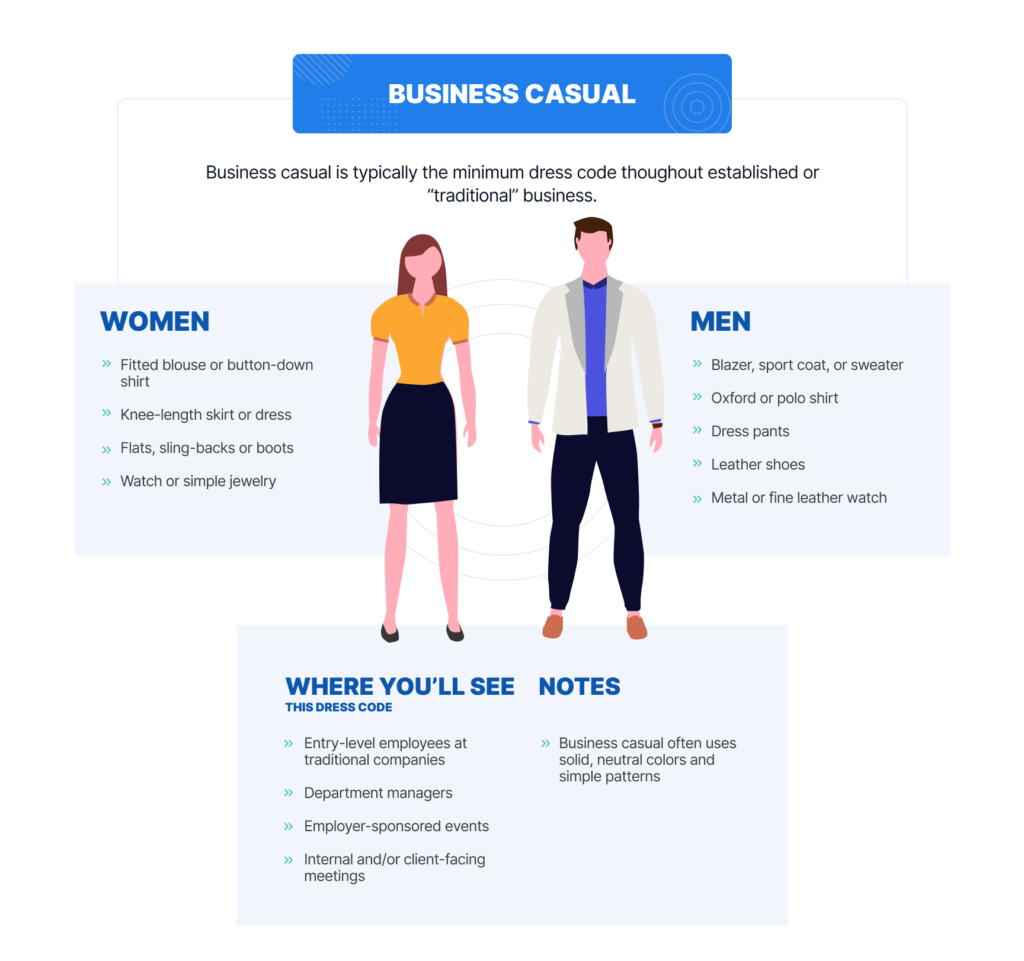 Across all companies, you’ll probably see business casual dress the most.
Across all companies, you’ll probably see business casual dress the most.
It’s considered a professional middle-ground that doesn’t demand excessive spending. For men, business casual can include a jacket, collared shirt, dress pants, leather shoes, and wrist watch. Still, there’s some variation in these guidelines, and some companies now accept jeans and other “relaxed” clothing as part of business casual.
For women, business casual can include a fitted top, dress, skirt, a variety of boots, and a variety of accessories. There’s also lots of variation in these guidelines as well, perhaps more than men’s since women’s fashion tends to be more open-ended. In other words, as long as you have a professional “look” to you, you could qualify as business casual.
5. Business formal
Business formal is the finest attire you’ll see in a business. It’s typically worn by executives, board members, and fresh-faced new hires who dream of one day running the company. 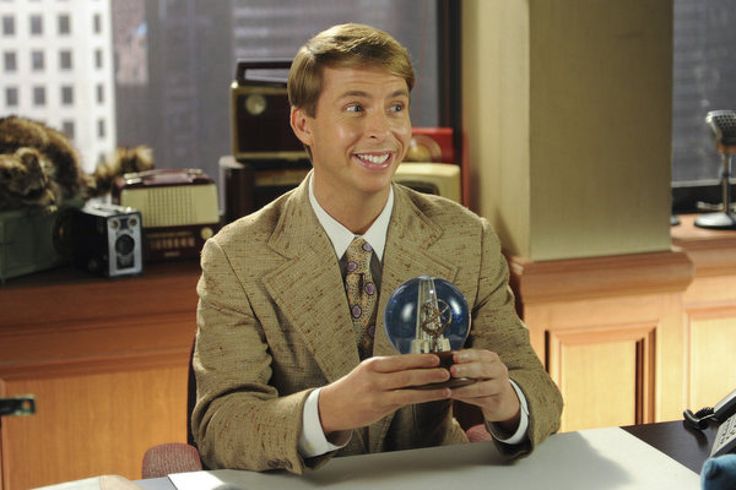 Traditional business formal is designed to convey a sense of power, professionalism, and confidence for both men and women.
Traditional business formal is designed to convey a sense of power, professionalism, and confidence for both men and women.
It follows a few standard rules, but it leaves enough breathing room for each executive to find his or her personalized “sweet spot” in attire. 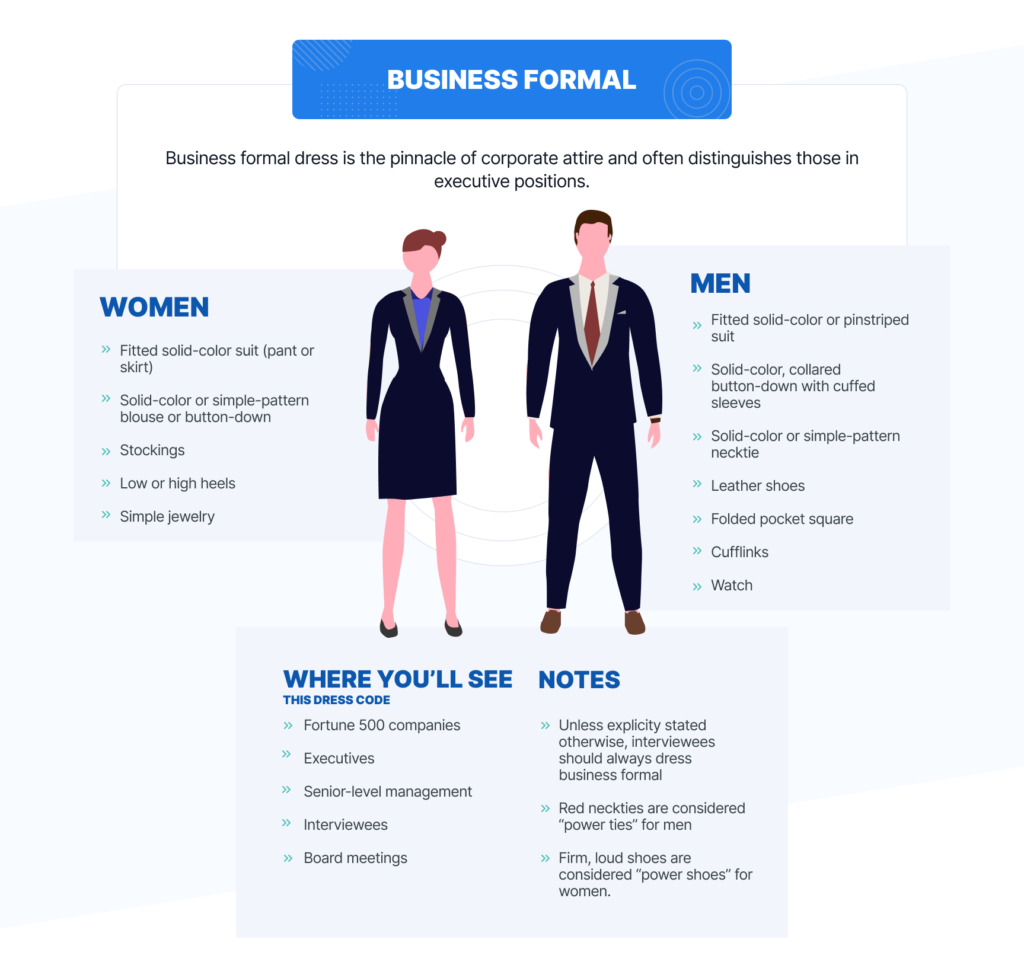 For men, business formal clothing requires a solid-color or pinstriped suit that’s usually dark and tailored. It requires a button-down shirt with a coordinated tie, leather shoes, cufflinks, a watch, and (optionally) a pocket square.
For men, business formal clothing requires a solid-color or pinstriped suit that’s usually dark and tailored. It requires a button-down shirt with a coordinated tie, leather shoes, cufflinks, a watch, and (optionally) a pocket square.
For women, business formal attire includes a fitted solid-color suit (pant or skirt) with a corresponding blouse, stockings, heeled shoes, and simple jewelry and/or a watch. The most important part about business formal dress is that it has the potential to get you a job. Interviews are one of the only times in a person’s life when it’s okay and even expected to overdress for an occasion, so it’s smart to go with business formal every time.
Plus, if you really want to play with the style, men can play around with different ties and women can experiment with shoes. While this may not sound that important, these accessories symbolize certain power dynamics — like dominance. Red ties are “power ties” for men.
They’re an eye-catching color that distracts someone by drawing their attention to the wearer’s chest instead of their eyes. Red ties are often worn in negotiations to gain an unspoken edge over someone’s opponent — kind of like bringing brass knuckles to a fistfight. Loud shoes are “power shoes” for women.
Power shoes are heeled shoes that create a sense of confidence and dominance by making sure people hear you approach long before they see you, not unlike the tyrannosaurus from Jurassic Park. It may not seem like much, but it’s the perfect way to build tension or throw off an opponent in negotiation before you ever speak a word — especially on hard floors. So if you’re looking to create a negotiation dream team, partner a strong-willed man with a strong-willed woman to dominate the boardroom.
6. Semi-formal
Semi-formal dress is the base attire for sophisticated social events. The clothing is more expensive than previous dress codes because it typically needs to be tailored. Everything from the suit jacket to the gown needs to be hand-modified to make it fit like a dream.
It’s also the sloppiest you’ll ever see James Bond.  Anyway, this is the required attire for a semi-formal occasion.
Anyway, this is the required attire for a semi-formal occasion. 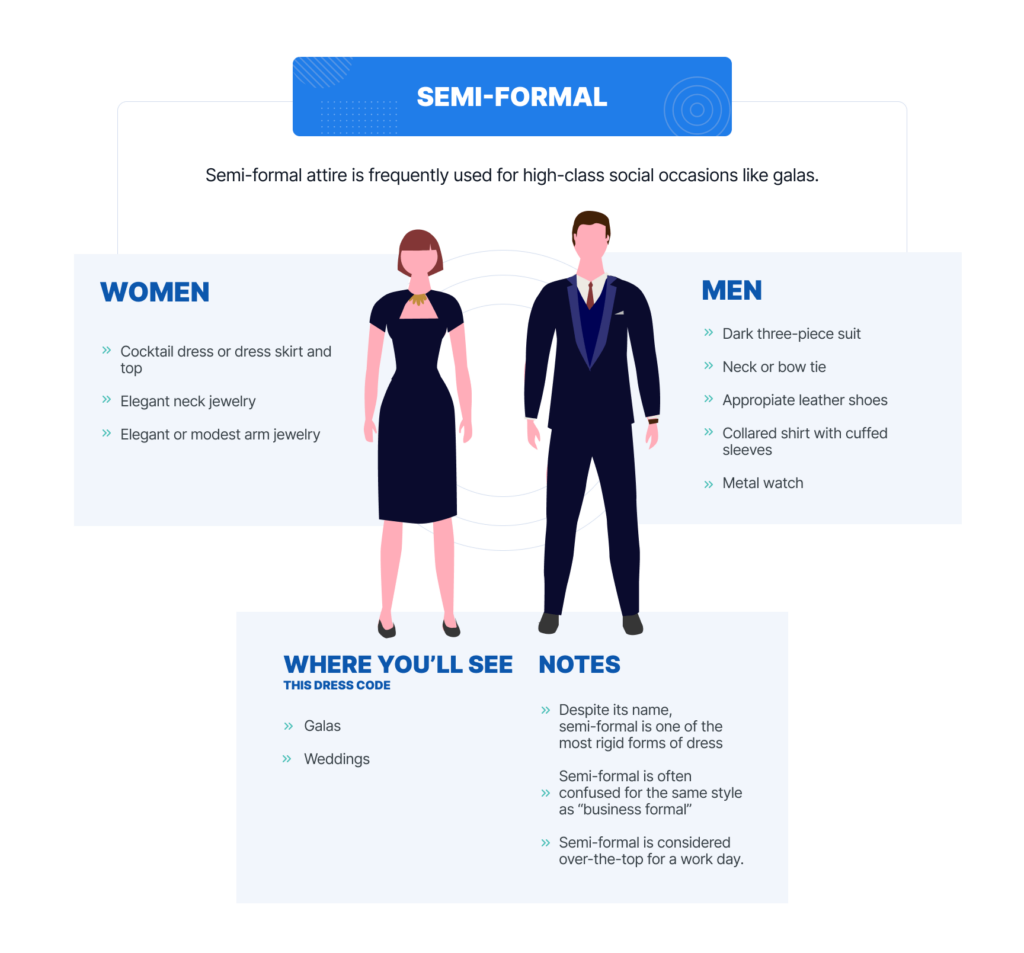 The traditional three-piece (jacket, pants, vest) suit is the cornerstone of male semi-formal attire.
The traditional three-piece (jacket, pants, vest) suit is the cornerstone of male semi-formal attire.
It’s also implied that the suit should be dark most of the time, though that social rule has relaxed more over the past few years. The suit should be worn with a shirt, fine watch, and leather shoes. For women, semi-formal dress incorporates a cocktail dress or skirt-and-top ensemble.
It also requires heels, neck jewelry, and arm jewelry with some type of small purse or clutch. In general, semi-formal attire is fairly strict — or at least stricter than any other dress code we’ve seen so far. You’ll rarely ever see it in an office.
If anyone does dress semi-formal for work, it’s usually considered over-the-top. That’s why it’s reserved for social occasions almost exclusively. But hey — dress for the job you want, right?
7. Black tie
Black tie apparel is also known as “tuxedo” for men and “evening gown” for women. While tuxes and gowns can be worn for different dress codes, they’re most frequently worn for black tie galas, dinners, and any other event that may include the phrase “a who’s who.” 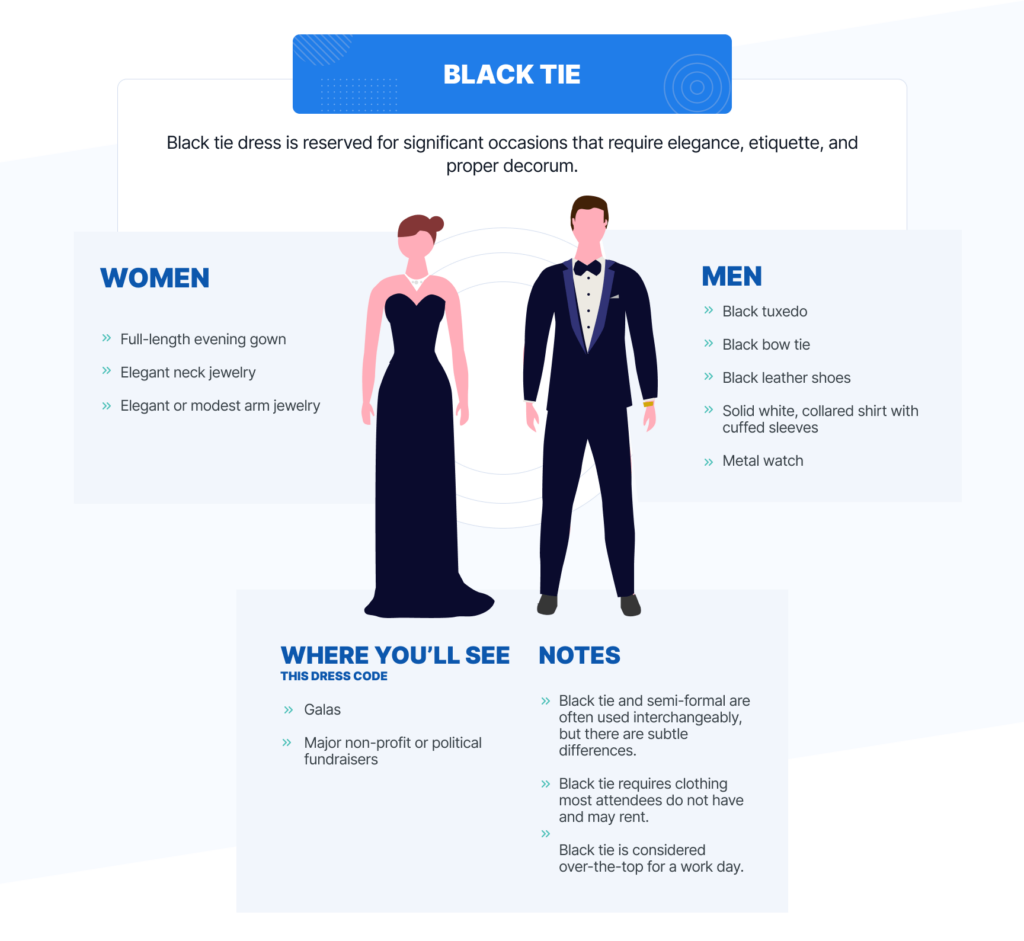 Also, if you’re an executive, it’s practically expected attire after 6:00.
Also, if you’re an executive, it’s practically expected attire after 6:00. 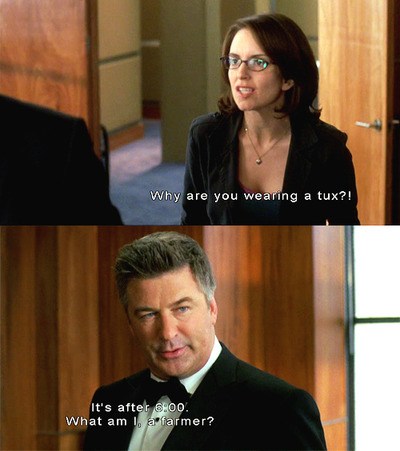 30 Rock references aside, black tie is fairly straightforward since it’s so strict. For men, it requires a black tux, a black bow tie, black leather shoes, a solid white shirt, and a nice metal watch. You can even rent the tux if you don’t think you’ll ever wear it again.
30 Rock references aside, black tie is fairly straightforward since it’s so strict. For men, it requires a black tux, a black bow tie, black leather shoes, a solid white shirt, and a nice metal watch. You can even rent the tux if you don’t think you’ll ever wear it again.
Like almost all things fashion, it’s a little more complicated for women. Evening gowns come in such a huge variety that it can be hard to pin the perfect one. The same goes for arm and neck jewelry, which help create a cohesive ensemble.
Clearly, you’re not going to see someone at the workplace in a tux (unless it’s after 6:00) or a gown. Black tie attire is reserved for social occasions that allow people from all kinds of power positions in business, politics, and non-profits rub elbows in clothes worth several dozen tuition payments to a new college graduate. Still, a gentleman (or “gent,” if the occasion is a soiree) can return a tux.
Unfortunately, a woman can’t often return a gown, if ever. Regardless of your sex though, you’re looking at a price tag of at least a few hundred dollars, if not a few thousand. And while that beats the cost of most people’s eveningwear (like pajama pants and a 12-year-old t-shirt), there’s still one more step up for when an evening just can’t get any fancier.
8. Formal / White tie
Formal / white tie is the pinnacle of Western dress. It’s the highest of high society, and it’s almost exclusively reserved for regal ceremonies, political gatherings, and muppets. 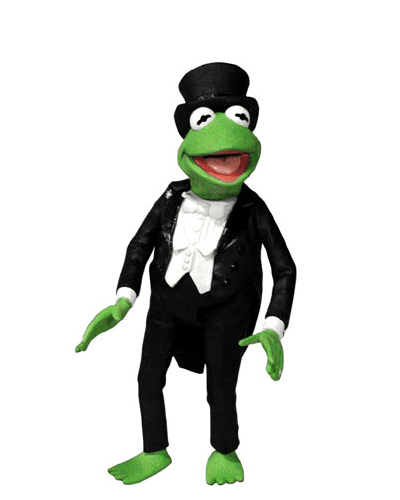 Formalwear is where you’ll find the old-school, classy clothing that you might see in photos or paintings of people dressed up in the past.
Formalwear is where you’ll find the old-school, classy clothing that you might see in photos or paintings of people dressed up in the past.
It’s frequently confused with business formal as well, which would lead to a major faux paus when you’re invited to the birthday of King Carl XVI Gustaf of Sweden. 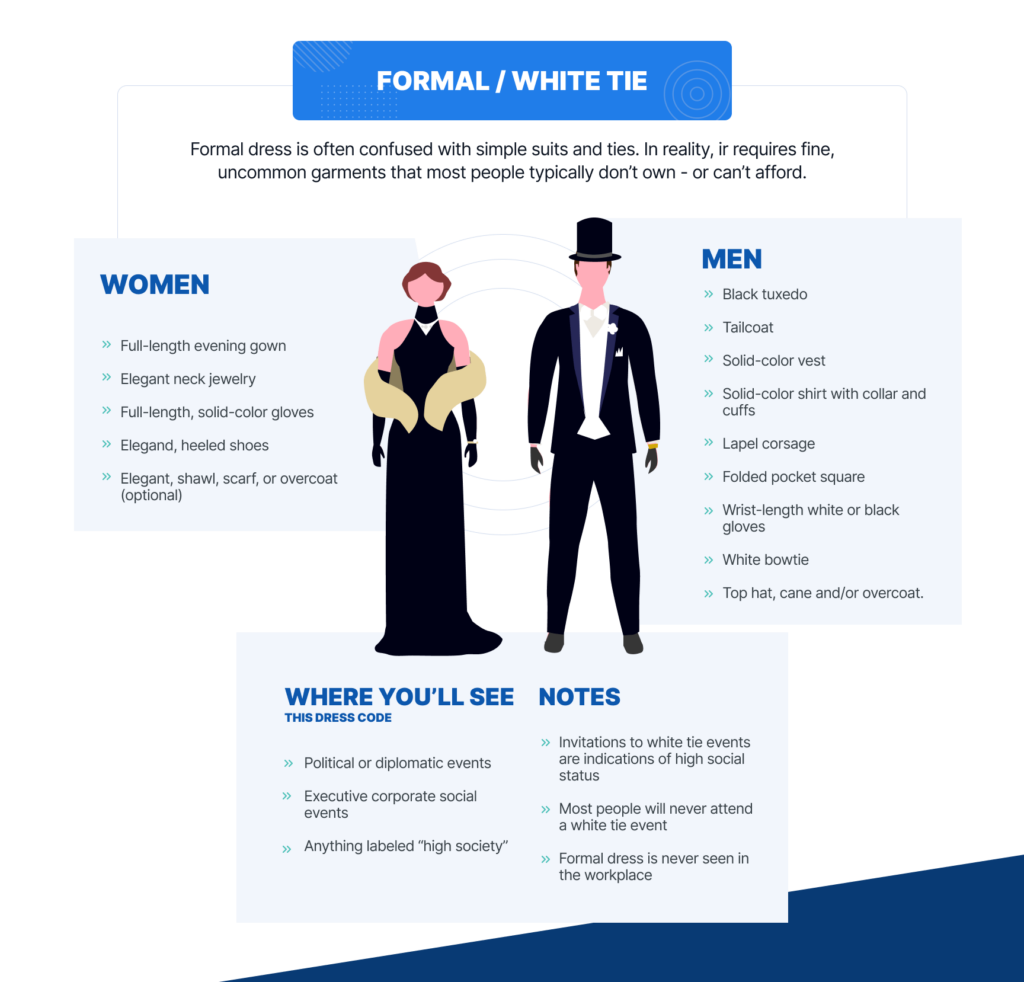 For men, formal / white tie apparel includes a black tuxedo with a matching tailcoat, solid-color vest, white collared shirt, cuffs, pocket square, corsage, top hat, overcoat, and timepiece (usually a pocket watch). That’s a laundry list for men compared to other dress styles in this infographic.
For men, formal / white tie apparel includes a black tuxedo with a matching tailcoat, solid-color vest, white collared shirt, cuffs, pocket square, corsage, top hat, overcoat, and timepiece (usually a pocket watch). That’s a laundry list for men compared to other dress styles in this infographic.
But it’s also the classic appearance that you’ll find at the world’s ritziest events. For women, the dress is similar to black tie attire with a few twists. Black is the preferred color for a gown, and accessories like full-length gloves, shawls, and scarves give the attire an unbeatable sophistication.
Top it off with fine, elegant jewelry, and you’re ready for the most socially specific evening of your life! But there’s a catch to this dress code — you probably won’t get to use it in your life. The clothing and accessories get so expensive that the average person couldn’t afford them anyway.
There’s also the cost of having the clothes tailored since you can’t really buy a “large tuxedo” or “medium full-length evening gown.” Then there’s also the cost of the evening’s occasion, which probably requires you to donate or give something away. All of those costs add up. And if you’re a normal person — or a not-billionaire — you probably have things like mortgages and student loan payments instead of a Desmond Merrion or Gucci.
But virtual reality is making a comeback, so you never know.
How do you dress for work?
What’s your dress code for your business? Do you go casual or a little more dressed up?
Or do you follow Jack Donaghy’s example and wear a tux after 6:00? Share your ideas with the world by reposting this infographic on your own site! You just might change the face of company fashion.
-
 Trevin serves as the VP of Marketing at WebFX. He has worked on over 450 marketing campaigns and has been building websites for over 25 years. His work has been featured by Search Engine Land, USA Today, Fast Company and Inc.
Trevin serves as the VP of Marketing at WebFX. He has worked on over 450 marketing campaigns and has been building websites for over 25 years. His work has been featured by Search Engine Land, USA Today, Fast Company and Inc. -

WebFX is a full-service marketing agency with 1,100+ client reviews and a 4.9-star rating on Clutch! Find out how our expert team and revenue-accelerating tech can drive results for you! Learn more
The Internet in Real Time
Ever wonder how much is going on at once on the Internet? It can be tough to wrap your mind around it, but we’ve put together a nice visual that’ll help! The numbers show no sign of slowing down either.
Find out More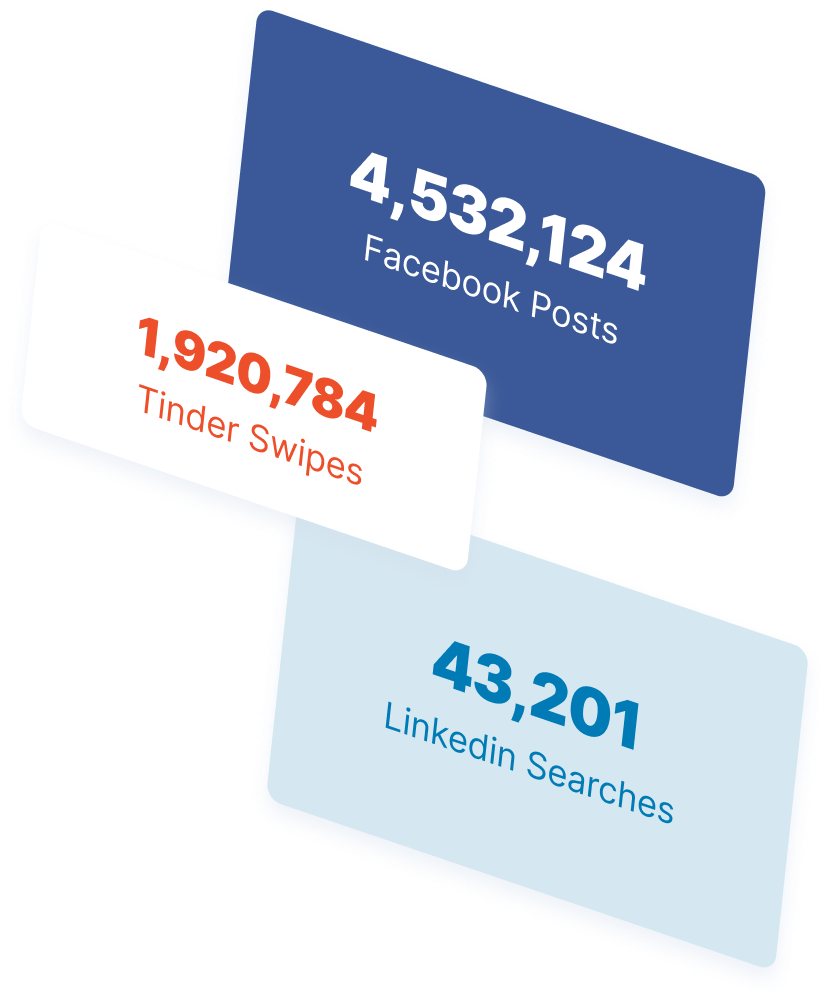

Ready to Drive Results for Your Business?
See how WebFX uses SEO, PPC, Social Media, and Web Design to Drive Revenue for Businesses.
Get InspiredThe Internet in Real Time
Ever wonder how much is going on at once on the Internet? It can be tough to wrap your mind around it, but we’ve put together a nice visual that’ll help! The numbers show no sign of slowing down either.
Find out More

